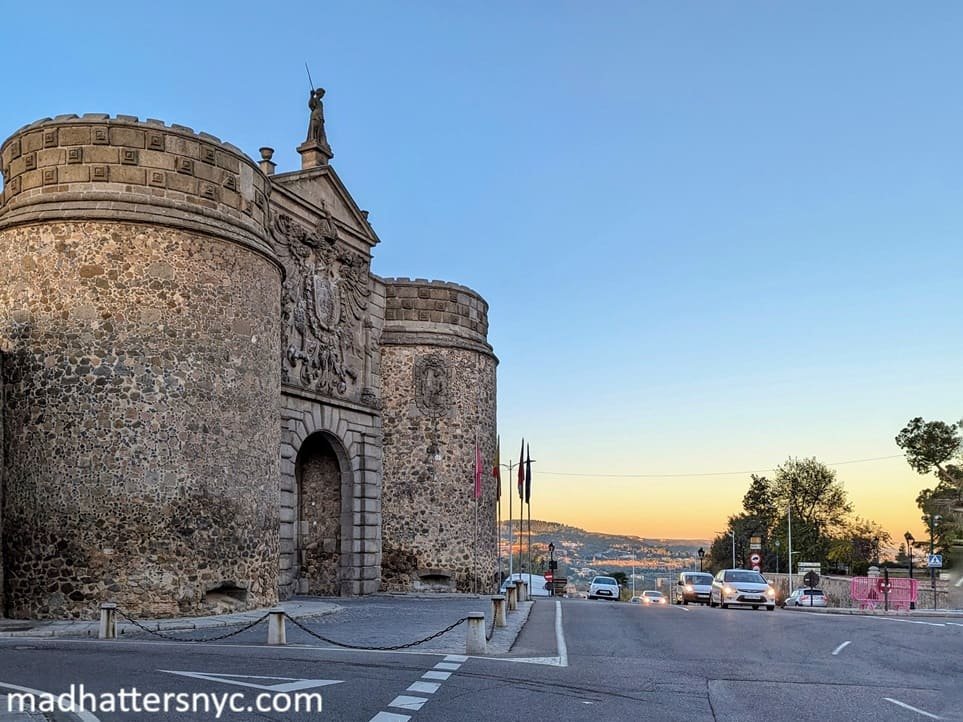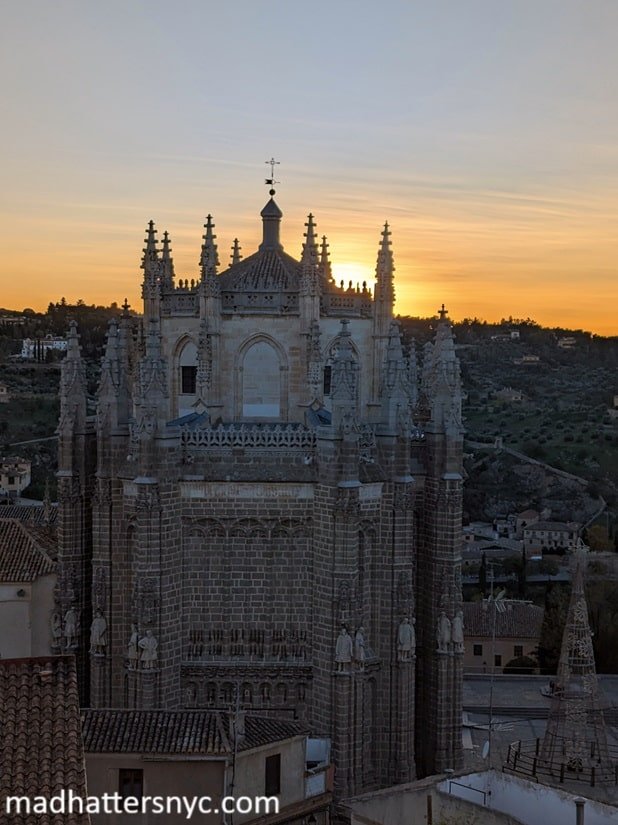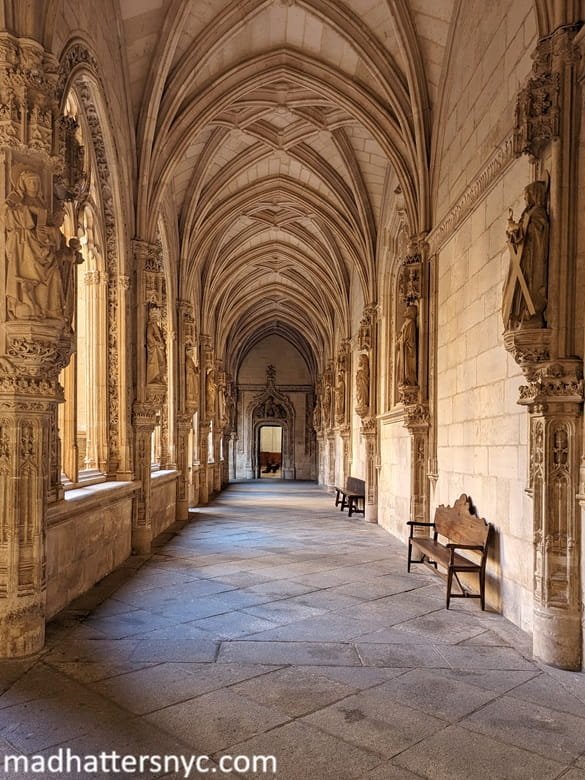Planning a Day Trip to Toledo? Why 2 Days is Better
Nestled on the banks of the Tagus River, Toledo is a mere stone's throw from Madrid and is a popular day trip destination from Spain’s capital city. But visiting Toledo is akin to entering a living museum, where Sephardic, Moorish, and Christian legacies linger. While a day trip may offer a glimpse, two days will allow the true essence of Toledo to be fully appreciated. I fell in love with this city, and I’m convinced if you give it enough time, you will too.
Why is Toledo important?
Recognized as a UNESCO World Heritage Site, Toledo remains a symbol of Spain's diverse cultural heritage and a testament to its enduring legacy throughout the centuries. Toledo has been a focal point of Spanish history for over two millennia. Its strategic location atop a hill by the Tagus River made it an ideal site for settlement since ancient times. The city's origins can be traced back to pre-Roman civilizations, but it flourished under Roman rule, known then as Toletum.
Following the collapse of the Roman Empire, Toledo fell under Visigothic control and became the center of Christian culture. This period saw the construction of significant churches and the establishment of Christianity as the dominant religion. In 711 AD, Toledo was conquered by the Moors during the Islamic expansion into the Iberian Peninsula. The city thrived under Muslim rule, becoming a vibrant center of Islamic culture, art, and learning. The coexistence of Christians, Jews, and Muslims during this period earned Toledo its reputation as the "City of Three Cultures."
In the 11th century, Toledo was reconquered by Christian forces during the Spanish Reconquista and regained its status as a Christian stronghold. Its strategic importance as a military stronghold and cultural center continued during the reign of the Catholic Monarchs, Ferdinand II of Aragon and Isabella I of Castile, who unified Spain in the late 15th century.
How do I get from Madrid to Toledo?
By train
Traveling from Madrid to Toledo by train only takes a little over 30 minutes on the high-speed Avant train, and costs approximately €11 one way. You can purchase your tickets online from Renfe, Spain’s national railway. It’s helpful to know Madrid has two train stations, Atocha and Chamartin. To travel to Toledo, you need to leave from Atocha. On Renfe’s website, use Madrid Pta. Atocha - Almudena Grandes as your departure point. Madrid Atocha Cercanías is for commuter trains which do not travel to Toledo. Trains between Madrid and Toledo are frequent, with approximately 10 trains a day between 8:00 am and 8:00 pm.
Another bonus of traveling by train? Toledo’s stunning train station sets the stage for what’s to come.
By bus
Traveling from Madrid to Toledo by bus takes between 1-1.5 hours, depending on the route. Bus operator ALSA has multiple buses that travel from Madrid to Toledo between 6:00 am to midnight. You can purchase a flex ticket online for approximately €6 one way, then review the schedule to decide which bus best meets your needs. Buses leave from the Plaza Eliptica bus station, which is accessible via Metro.
You can also join a private bus tour company for a day trip for as little as €25 per person. Though you’ll have less autonomy, the tour companies are skilled and efficient.
By private car hire
If you’re traveling in a larger group, you can opt for a private tour service which picks you up from your hotel and drives you to Toledo and back in an air-conditioned luxury minivan. This option works well for travelers with mobility challenges or for a multi-generational group, and can accommodate up to 7 people.
The Essential Toledo Day Trip Itinerary
Toledo's rich historical and cultural heritage is evident in its well-preserved medieval architecture, including its iconic Alcázar fortress, Gothic cathedral, and labyrinthine old town. If you’re only able to visit on a day trip, don’t miss these essential stops.
Toledo Cathedral
The Toledo Cathedral, or Catedral Primada Santa María de Toledo, stands as a crowning jewel of Gothic architecture in Spain. Built over several centuries, beginning in the 13th century and completed in the 15th century, the cathedral showcases a harmonious blend of architectural styles, including French Gothic, Spanish Baroque, and Mudéjar influences.
Inside, the vast interior features stunning stained glass windows, elaborate altarpieces, and intricately carved choir stalls. One of my personal favorites was the Transparente, a masterpiece of Baroque sculpture with a unique skylight that bathes the high altar in ethereal light. Other highlights include the Mozarabic Chapel, a rare example of Mozarabic art and architecture in Spain, and the Sacristy, featuring works by El Greco, Goya, Titian and Caravaggio.
Beyond its architectural splendor, the Toledo Cathedral holds immense cultural and historical significance. As the seat of the Archdiocese of Toledo, it has played a central role in Spain's religious and political history for centuries. Plan to spend at least 2 hours here to take everything in. Visit with a tour guide or download the free audio guide so you can fully appreciate all the intricate details.
Pro Tip: There is an entrance for worshippers only, which is free and does not allow entrance to the full cathedral. To purchase tickets, visit the gift shop on Calle Cardenal Cisneros across from the Puerta de los Leones.
Mezquita del Cristo de la Luz
The Mezquita del Cristo de la Luz, translated as the Mosque of Christ of the Light, stands as a remarkable testament to Toledo's multicultural past and Islamic heritage. Originally constructed in the 10th century during the Islamic period of Spain's history, this small but stunning mosque has survived centuries of transformation to become not only Toledo’s oldest standing monument, but one of its most cherished landmarks.
Though tiny in comparison to the Toledo Cathedral, the intimate space is particularly humbling, with a unique blend of Islamic and Christian influences. Its horseshoe arches, intricately carved stucco decorations, and geometric motifs are typical of Islamic architecture, while the addition of a Christian apse and altar in the 12th century reflects the city's gradual transition from Islamic to Christian rule. My favorite details were the nine individual vault designs, heavily inspired by Andalusian architecture of the period, and the beautifully restored external facade featuring the centuries-old Arabic inscription linking it to the prestigious Banū l-Hadīdī family.
Also take the time to walk through the exterior courtyard, which leads to a beautiful viewing point where you can take in some of the ancient city’s most famous structures.
Synagogue of Santa María la Blanca
To round out your experience in the City of Three Cultures, visit the Synagogue of Santa María la Blanca in the Jewish Quarter. The synagogue dates back to the 12th century and is a spectacular example of Mudéjar design. Mudéjar art is the art of the Muslims who remained in the Iberian Peninsula after the Christian Reconquista, and can be described as the fusion of Islamic and Christian artistic influences. Although built to serve a Jewish congregation, the craftwork of the Muslim stonemasons is clear. The Mudéjar design features circular horseshoe arches, delicate ornamentation with vegetal and geometric motifs, and medallions decorated with different knotwork designs. The synagogue was converted into a church, taking the name of Santa María la Blanca in the 15th century, a few decades before the tragic expulsion of the Jews from Spain.
El Greco Museum
El Greco, or The Greek, was born in 1541 in the village on the island of Crete. After studying art in Venice and Rome, El Greco moved to Spain, settling in Toledo. Though his art wasn’t particularly popular during his lifetime, he is now regarded as one of the most significant artists of the Spanish Renaissance and a pioneer of Mannerism, an artistic style characterized by elongated proportions, vivid colors, and emotional intensity.
The El Greco Museum, nestled in the heart of Toledo's historic old town, is housed in a 16th-century Renaissance palace. The museum offers visitors a journey through the life and work of the painter. Don’t miss The Apostolate, a set of thirteen paintings which capture his unique gift in emotive portraiture, and the famous View of Toledo.
Church of Santo Tomé
The Church of Santo Tomé was rebuilt over a former mosque, and its majestic bell tower, which dominates the skyline of Toledo's old town, was actually added to the former Muslim minaret. However, its true treasure lies inside. The highlight of a visit to Santo Tomé is the masterpiece by El Greco, The Burial of the Count of Orgaz. This monumental painting, considered one of El Greco's finest works, adorns the walls of the church's Sacristy. The Count of Orgaz was a nobleman and primary benefactor of the church, so a priest commissioned the artwork after his death. There is a replica of the famous piece in The Prado Museum, which is thought to be painted some years after El Greco’s death. That copy is smaller, and only captures the lower part of the original.
Paseo-Mirador Virgen de Gracia
If you’re a sunset lover, visiting Toledo is like winning the lottery. The medieval city is perched atop a hill, so finding a viewing point is child’s play. I love the combination of a sunset and an architectural point of interest, so I couldn’t pass up a visit to Paseo-Mirador Virgen de Gracia. The San Juan de los Reyes Monastery casts a stunning silhouette against the ocher sky.
Why should I spend 2 Days in Toledo?
We believe day trips are a fantastic way to add a complementary destination to your itinerary. Odense’s small town charm is the perfect juxtaposition to Copenhagen’s city bustle. Nikko’s majestic waterfalls are a refreshing contrast to Tokyo’s skyscrapers. But some destinations may leave you wanting if you limit yourself to a day trip.
More time for what you love
Depending on what time you plan to leave Toledo for the day, the six stops mentioned above could already be a fairly tight squeeze. But if you have an additional day in this magical city, then not only can you add more destinations to your itinerary, you can allow yourself to linger at your favorites or take a more leisurely pace. And with Toledo’s hilly topography, building in some breaks could be prudent.
Cost savings
In addition, Toledo offers a tourist wristband which allows access to 7 of its historic monuments at the price of 3. It can save you time at each location since you don’t have to wait to buy separate tickets, and can simply flash your band for a quick scan. It also allowed me to revisit the Church of Santo Tomé after I encountered a large tour group my first time around.
Delicious local cuisine
Last but not least, Toledo is home to some fantastic restaurants, and an additional day means you get to enjoy dinner at one of its delightful eateries. I found that Alfileritos 24, which came highly recommended by a resident, lived up to its stellar reputation. Taberna Botero is another local favorite. I recommend making reservations in both cases.
Day 2 Itinerary: Bonus Stops to Consider
San Juan de los Reyes Monastery
The San Juan de los Reyes Monastery stands as a magnificent example of late Gothic architecture and a symbol of Spain's golden age. Commissioned by King Ferdinand II of Aragon and Queen Isabella I of Castile to commemorate their victory at the Battle of Toro in 1476, the monastery was a grandiose testament to royal power and religious devotion. It was intended as a royal mausoleum for Ferdinand and Isabella, though they eventually chose Granada as their resting place.
Inside the monastery, you’re greeted by a magnificent cloister, adorned with elegant ribbed vaults and graceful arcade, while the second floor has a unique Mudéjar carved wood ceiling. The church features intricate altarpieces and exquisite stained glass windows. Its main chapel is decorated with the coats of arms of the Catholic Monarchs supported by large eagles.
Museum of Santa Cruz
The Museum of Santa Cruz is a renowned art and history museum located in the heart of Toledo. Housed in a magnificent Renaissance building originally constructed as a hospital in the 16th century, the museum has an extensive collection of artworks and artifacts spanning various periods of Spanish history and culture.
The museum houses several additional El Greco works, including the famous The Dream of Philip II. Unfortunately, during my visit, the area was under construction and the paintings had been removed. However, there were still many worthwhile pieces to enjoy, like the works of Luis Tristán, a disciple of El Greco’s, sculptures by Alonso Berruguete, and numerous stunning religious artifacts like altarpieces and stained glass windows. Due to the ongoing maintenance work, entrance to the museum is free until December 31, 2024.
Pro Tip: If you’re visiting the Museum of Santa Cruz, bibliophiles should keep an eye out for the statue of Miguel Cervantes, conveniently located between the museum and Plaza Zocodover, the city’s central square. The statue was erected to commemorate the 400th anniversary of Don Quixote.
The Alcázar
The Alcázar is a historic fortress that has played a significant role in the city's past and is considered one of Toledo's most iconic landmarks. Today, the Alcázar houses several museums and cultural institutions, including the Army Museum and the Library of Castilla-La Mancha. Its imposing façade is a striking part of Toledo’s skyline. However, access was limited when I visited, and upon researching further, appears to have been so for some time. I couldn’t locate any information on when that may change. Personally, I found the highlight to be the 360-degree views from the cafeteria, which is located above the library. Feel free to pass on this one, unless you’re a big fan of military history, or you can confirm in advance that it has fully reopened to the public.
Mirador del Valle
Mirador del Valle is a popular viewing spot that offers spectacular panoramic views of Toledo from across the Tagus River. While you can certainly hop into a taxi and ask the driver to take you there, I highly recommend walking there if you can. Toledo is hemmed in on three sides by the Tagus, and two iconic bridges ornament opposite sides of the city. The San Martín Bridge lies to the west, and the Alcántara Bridge lies to the east. Each one offers a glimpse into the city's rich architectural heritage. The San Martin Bridge is characterized by its towering central arch, bound by smaller semicircular arches. Atop the central arch stands a fortified tower, originally built as a defensive gate to control access to the city. The Alcántara Bridge consists of a single semicircular arch, but is flanked by two imposing towers, known as the Gate of Alcántara.
I walked from the San Martin Bridge to the Alcantara Bridge, and the path is approximately 2.5 miles long. Mirador del Valle is midway through, so I timed my walk to arrive there for sunset. The walk took about 1.5 hours with all stops included, and I was able to enjoy views of the city (and cross paths with many avid runners and bikers!) along the way. Just note it involves some inclines, so your glutes will get a decent workout.
Conclusion
Whether you’re embarking on a day trip or immersing yourself in a longer stay, Toledo offers a journey through the ages. It's a place where history comes to life, where art and architecture inspire the imagination, and where every moment is infused with the magic of discovery. Don’t miss this gem.


























